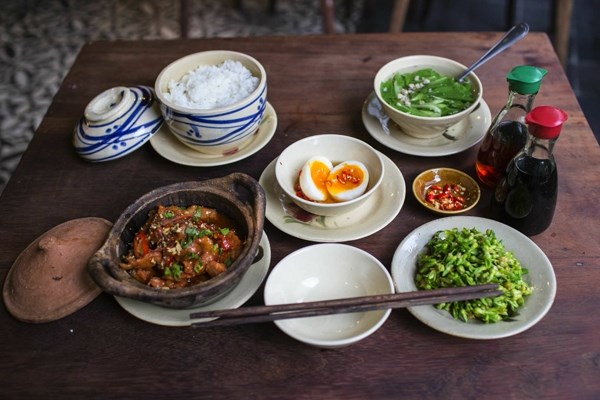According to Vietnamese ancestors, choosing proper spices can balance out the yin and yang in dishes. As for Nguyen Tuan, a Vietnamese culinary expert, home is where you can find Vietnamese flavors and eat in Vietnamese style.
Sometimes,
being away from home means no familiar flavors, no taste balance in served
meals. The empty feeling when there are no little greeny leaves in your dishes.

In
2005, I visited two of my friends who were artists in Paris. One of them was an
Opera singer and the other played piano. Both of my friends had their own
gardens and were interested in gardening, greens, roses, flowers, etc. Then, I
recognized there were beds of mint basil, celery, houttuynia cordata, chilly,
along with small lime trees, baby tomatoes, etc. among the beautiful, colorful
blossoms, staying next to the window. The pianist was not a big fan of chilly
but really into wormwood (Artemisia Absinthium) smell-and-look alike
vegetables. Picking up those veggies near the fences and cooking them with eggs
was good for your health and able to cure headache. My friend believed: spices
in Vietnamese food were the best natural medicines. My pianist friend also
liked to grow lemongrass for fish dishes, generating a delicious smell over the
contemporary kitchen. My friends have travelled thousands miles from Vung Tau
and Hanoi to relocate in Paris. Were they still missing the Vietnamese flavors
after all these years?
As
a guest, I was asked by my friend to pick some mints from the garden with a
caution: just take a little from each kind to save for the next meals. For
every Vietnamese meal, my friend had to calculated the usage amount of home
grown ingredients. In the worst case, she had to go to Vietnamese market in
District 13 for some groceries. Normally, she would get some bean sprouts,
turmeric powder, fresh shrimps for “bánh xèo”, houttuynia cordata, Hanoian
parsley, mushrooms, carrots, etc. Basically, all the ingredients to make the
spring rolls. There was a divorced French guy who had no kids. He chose to
visit my friend’s house on every Sunday as a way to overcome his sadness. He’d
like to eat only 2 dishes: spring rolls and “bánh xèo” and never asked for any
Western flavors.
I
secretly observed “Olive” for the whole meal. I’d call him Olive (a delicious
salted berry) since I couldn’t remember his name. He didn’t even notice because
he was busy picking the mint leaves, rolling them together with bánh xèo and
dipping the whole thing into the fish sauce prepared by my friend. Olive even
drank the fish sauce left in his bowl. He kept complimenting my friend for such
a delicious meal and called her “The witch of Vietnamese culinary”. Provided
beef, chicken and pork, Olive asked himself why he couldn’t cook as delicious
as my friend did. I teased him by pointing at my friend’s pile of spices in the
kitchen and said: “Because Olive haven’t learnt how to use Vietnamese spices”.
My friend and her husband suggested Olive to get a Vietnamese wife so he could
enjoy Vietnamese food everyday. He startled: “Searching for a Vietnamese wife
with good cooking skills is not that easy! I give up!!!”
The
philosophy of using spices in Vietnamese dishes follows the rules of yin and
yang just like the connection between human and universe according to our
ancestors. Hence, spices do not only supplement but also enhance the taste in
order to create a mixture, a harmony in flavors as a whole. This amalgamation
is illustrated through the ingredient combining process: vegies with vegies,
vegies with seasonings, fish, meat, beans, eggs, etc. Vietnamese soup has a
million outcomes. For example, the sweet and sour snakehead fish soup has dozen
of spices and vegies. So does the crab, colocasia esculenta and neptunia
oleracea soup. Vietnamese people do not prefer to cook soup without spices.
There is an idiom about this tradition: Soup without spices is like suits
without pants. Therefore, the principle of complementarity between spices is
the leading rule of cooking. In order to prepare a delicious dish, it has to
contain 5 elements including flour, water, minerals, protein and fat along with
5 tastes – sweet, salty, sour, spicy and bitter. When cooking and preparing,
the dish should have 5 colors of red, black, blue, white and yellow. The whole
preparation process leads to the Vietnamese unique eating style. With people
sitting around the table, the more dishes, the more combinations one can
create. This eating style somehow stimulates 5 senses of human including the
smell of good foods, the sound of chewing, the taste of delightful dishes, the
comfortable feeling of picking up a piece of chicken or sweet rice, etc.
without using chopsticks.
Harmonizing
all of the above factors in eating, Vietnamese has reached to a whole new level
of relishing: good food, beautiful weather, nice eating ambience, presence of
best friends gathering together, joy and happiness. Vietnamese folks once said:
Good wine has to come with good friends. Otherwise, not buying wine doesn’t
mean we have no money!
Writer: Prof. Nguyen Thi Minh Thai
Translator: Thu Pham